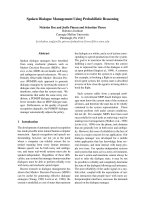Báo cáo khoa học: "RESOLUTION OF COLLECTIVE-DISTRIBUTIVE USING MODEL-BASED REASONING" pdf
Bạn đang xem bản rút gọn của tài liệu. Xem và tải ngay bản đầy đủ của tài liệu tại đây (624.5 KB, 8 trang )
RESOLUTION OF COLLECTIVE-DISTRIBUTIVE AMBIGUITY
USING MODEL-BASED REASONING
Chinatsu Aone*
MCC
3500 West Balcones Center Dr.
Austin, TX 78759
Abstract
I present a semantic analysis of collective-
distributive ambiguity, and resolution of such am-
biguity by model-based reasoning. This approach
goes beyond Scha and Stallard [17], whose reasoning
capability was limited to checking semantic types.
My semantic analysis is based on Link [14, 13] and
Roberts [15], where distributivity comes uniformly
from a quantificational operator, either explicit (e.g.
each)
or implicit (e.g. the D operator). I view
the semantics module of the natural language sys-
tem as a hypothesis generator and the reasoner in
the pragmatics module as a hypothesis filter (cf.
Simmons and Davis [18]). The reasoner utilizes a
model consisting of domain-dependent constraints
and domain-independent axioms for disambiguation.
There are two kinds of constraints, type constraints
and numerical constraints, and they are associated
with predicates in the knowledge base. Whenever
additional information is derived from the model,
the Contradiction Checker is invoked to detect any
contradiction in a hypothesis using simple mathe-
matical knowledge. CDCL (Collective-Distributive
Constraint Language) is used to represent hypothe-
ses, constraints, and axioms in a way isomorphic
to diagram representations of collective-distributive
ambiguity.
1 Semantics of Collective-
Distributive Ambiguity
Collective-distributive ambiguity can be illustrated
by the following sentence.
(1) Two students moved a desk upstairs.
(1) means either that two students
TOGETHER
moved one desk (a collective reading) or that each
*The work described in this paper was done as a part of
the author's doctoral dissertation at The University of Texas
at Austin.
of them moved a desk
SEPARATELY (a
distributive
reading). Following Link [14, 13] and Roberts [15],
distributivity comes from either an explicit quantifi-
cational operator like
each
or an implicit distributive
operator called the D operator. The D operator
was motivated by the equivalence in the semantics
of the following sentences.
(2) a.
Every
student in this class lifted the piano.
b. Students in this class
each
lifted the piano.
c. Students in this class lifted the piano.
(the distributive reading)
Thus, the distributive readings of (1) and (2c) result
from applying the D operator to the subjects.
Now, look at another sentence "Five students ate
four slices of pizza." It has 8 POSSIBLE readings be-
cause the D operator may apply to each of the
two
arguments of
eat,
and the two NPs can take
scope
over each other. Thus, 2x2x2 = 8. i j have extended
Link's and Roberts's theories to quantify over events
in Discourse Representation Theory (cf. Kamp [10],
Heirn [9], Aone [2]) so that these readings can be sys-
tematically generated and represented in the seman-
tics module. However, the most PLAUSIBLE reading
is the "distributive-distributive reading", where each
of the five students ate four slices one at a time, as
represented in a discourse representation structure
(DRS) in Figure 1 ~. Such plausibility comes partly
from the lexical semantics of
eat.
From our "common
sense", we know that "eating" is an individual activ-
ity unlike "moving a desk", which can be done either
individually or in a group. However, such plausi-
bility should not be a part of the semantic theory,
but should be dealt with in pragmatics where world
knowledge is available. In section 2, I'll identify the
1Actually the two collective-collective readings are equiv-
alent, so there are 7 distinct readings.
2(i-part x I x) says "x I is an atomic individual-part of x"
(cf. Link [12]), and CU, i.e. "Count-Unit", stands for a natural
measure unit for students (cf. Krifka [11]).
(student x)
(amount x 5)
(measure x CU)
xl j
(i-part x' x)
Y
(pizza y)
(amount y 4)
(measure y slice)
y' e
D
(i-part y' y]' ,(eat e x' y')
Figure h DRS for "Five students ate four slices of pizza"
necessary knowledge and develop a reasoner, which
goes beyond Scha and Stallard [17].
There is a special reading called a cumulative
reading
(cf. Scha [16]).
(3) 500 students ate 1200 slices of pizza.
The cumulative reading of (3) says "there were 500
students and each student ate some slices of pizza,
totaling 1200 slices." The semantics of a cumulative
reading is UNDERSPECIFIED and is represented as a
collective-collective reading at the semantic level (cf.
Link [13], Roberts [15], Aone [2]). This means that a
cumulative reading should have a more specific rep-
resentation at the pragmatics level for inferencing.
Reasoning about cumulative readings is particularly
interesting, and I will discuss it in detail.
2 Model-Based Reasoning for
Disambiguation
Although scope ambiguity has been worked on by
many researchers (e.g. Grosz
et al.
[8]), the main
problem addressed has been how to generate all the
scope choices and order them according to some
heuristics. This approach might be sufficient as
far as scope ambiguity goes. However, collective-
distributive ambiguity subsumes scope ambiguity
and a heuristics strategy would not be a strong
method. I argue that the reason why some of the
readings are implausible (and even do not occur to
some people) is because we have access to domain-
dependent knowledge (e.g. constraints on predi-
cates) along with domaln-independent knowledge
(e.g. mathematical knowledge). I have developed a
reasoner based on the theory of model-based reason-
ing (cf. Simmons and Davis [18], Fink and Lusth [6],
Davis and Hamscher [5]) for collective-distributive
ambiguity resolution. The model that the reasoner
uses consists of four kinds of knowledge, namely
predicate constraints, two types of axioms, and sim-
ple mathematical knowledge. First, I will discuss the
representation language CDCL 3. Then, I will discuss
how these four kinds of knowledge are utilized during
reasoning.
2.1 CDCL
CDCL is used to represent collective-distributive
readings, constraints and axioms for reasoning.
There are three types of CDCL clauses as in (4),
and I will explain them as I proceed 4.
(4) Core clause: (1 ((5) a0 4 al))
Number-of clause: (number-of al ?q:num)
Number comparison clause: (<= ?q:num 1)
2.1.1 Expressing Collective and Distributive
Readings in CDCL
CDCL is used to express collective and distributive
readings. Below, a's are example sentences, b's are
the most plausible readings of the sentences, and c's
are representations of b's in CDCL.
(5) a. "5 students ate 4 slices of pizza."
b. Each of the 5 students ate 4 slices of pizza
one at a time.
c. (eat a0 al): (5 (1 a0 -* 4 al))
3CDCL stands for "Collective-Distributive Constraint
Language".
4Though not described in this paper, CDCL has been ex-
tended to deal with sentences with explicit quantifiers as
in
"Every student ate 4 slices of pizza" and sentences with n-ary
predicates as in "2 companies donated 3 PC's to 5 schools".
For example:
(i) (eat a0 al): (every (1 a0 -* 4 al))
(ii) (donate a0 al a2): (2 (1 a0 * (5 (1 a2 * (3) al))))
See Aone [2] for details of CDCL expressed in a context-free
grammar.
2
(6) a. "5 dogs had (a litter of) 4 puppies."
b. Each of the 5 mother dogs delivered a litter
of 4 puppies.
c. (deliver-offspring a0 al): (5 (1 a0 ~ (4) al))
(7) a. "5 alarms were installed in 6 buildings."
b. Each of the 6 buildings was installed with 5
alarms one at a time.
c. (installed-in a0 al): (6 (1 al * 5 a0))
First, consider (5c). The representation should
capture three pieces of information: scope relations,
distributive-collective distinctions, and numerical re-
lations between objects denoted by NP arguments.
In CDCL, a0 and al signify the arguments of a pred-
icate, e.g. (eat a0 al). The scope relation is repre-
sented by the relative position of those arguments.
That is, the argument on the left hand side of an ar-
row takes wide scope over the one on the right hand
side (cf. (5) vs. (7)). The numerical relation such as
"there is an eating relation from EACH student to 4
slices of pizza" is represented by the numbers before
each argument. The number outside the parenthe-
ses indicates how many instances of such a numerical
relation there are. Thus, (5c) says there are five in-
stances of one-to-four relation from students to slices
of pizza. CDCL is designed to be isomorphic to a di-
agram representation as in Figure 2.
p s p s p s p s p
\-p \-p \-p . \-p \-p
\-p \-p \-p \-p \-p
\-p \-p \-p \-p \-p
s = a
student
p = a s~ce of pizza
Figure 2:"5 students ate 4 slices of pizza."
As for the collective-distributive information in
CDCL, it was implicitly assumed in (5c) that both
arguments were read DISTRIBUTIVELY.
To
mark that
an argument is read
COLLECTIVELY, a
number be-
fore an argument i s written in parentheses where the
number indicates cardinality, as in (6c).
There are two additional symbols,
anynum
and
anyset
for representing cumulative readings. The
cumulative reading of (3) is represented in CDCL
as follows.
(s)
(500 (1 a0 * anynum0 al)) ~c
(1200 (1 al ~ anynuml a0))
In (8), the situation is one in which each student (a0)
ate a certain number of pizza slices, and the number
may differ from student to student. Thus,
anynumO
represents any positive integer which can vary with
the value of a0.
2.1.2 Constraints in
CDCL
CDCL is also used to express constraints. Each pred-
icate, defined in the knowledge base, has its associ-
ated constraints that reflect our "common sense".
Thus, constraints are domain-dependent. There
are two kinds of constraints:
type constraints
(i.e.
constraints on whether the arguments should be read
collectively or distributively) and numerical con-
straints (i.e. constraints on numerical relations be-
tween arguments of predicates.) There are 6
type
constraints (C1 - C6) and 6 numerical constraints
(C7- C12) as in Figure 3.
C1. (?p:num (1 ?a:arg * ?q:num ?b:arg))
:::~z inconsistent
"Both arguments are distributive."
C2. (1 (?p:set ?a:arg ~ ?q:set ?b:arg))
:=~ inconsistent
"Both arguments are collective."
C3. (?p:num (1 a0 ?r:set al)) :=~
inconsistent
C4. (1 (?q:set
al
~ ?r:num a0)) :=~
inconsistent
"lst argument distributive
and 2nd
collective."
C5. (1 (?p:set a0 * ?q:num al)) :=~ inconsistent
C6. (?p:num (1 al ~ ?q:set a0)) :=~ inconsistent
"lst argument collective and 2nd distributive."
C7. (?p:num (1 ?a:arg * ?q:num ?b:arg))
=~ (< ?q:num ?r:num)
C8. (?p:num (1 ?a:arg * ?q:num ?b:arg))
=~ (< ?r:num ?q:num)
C9. (?p:num (1 a0 , 1 al)) :=~ inconsistent
"A relation from a0 to al is a function."
C10. (?p:num (1 al , 1 a0)) :=~ inconsistent
"A relation from al to a0 is a function."
Cll. (1 (?p:set a0 * 1 al)) :=~ inconsistent
"Like C9, the domain is a set of sets."
C12. (1 (?p:set al * 1 a0)) :=~ inconsistent
"Like C10, the domain is a set of sets."
Figure 3: Constraints
Predicate constraints are represented as rules.
Those except
C7
and C8 are represented as "anti-
rules". That is, if a reading does not meet a con-
straint in the antecedent, the reading is considered
inconsistent. C7 and C8 are ordinary rules in that
if they succeed, the consequents are asserted and if
they fail, nothing happens.
The notation needs some explanation. Any sym-
bol with a ?-prefix is a variable. There are 4 variable
types, which can be specified after the colon of each
variable:
(9)
?a:arg
?b:num
?c:set
?d:n-s
argument type (e.g. a0, al, etc.)
positive integer type
non-empty set type
either num type or set type
If an argument type variable is preceded by a set
type variable, the argument should be read collec-
tively while if an argument type variable is preceded
by a number type variable, it should be read dis-
tributively.
To explain type constraints, look at sentence (6).
The predicate (deliver-offspring a0 al) requires its
first argument to be distributive and its second to
be collective, since delivering offspring is an individ-
ual activity but offspring come in a group. So, the
predicate is associated with constraints C3 and C4.
As for constraints on numerical relations between
arguments of a predicate, there are four useful con-
straints (C9 - C12), i.e. constraints that a given re-
lation must be a FUNCTION. For example, the pred-
icate
deliver-o~spring
in (6) has a constraint of a
biological nature: offspring have one and only one
mother. Therefore, the relation from al (i.e. off-
spring) to a0 (i.e. mothers) is a function whose do-
main is a set of sets. Thus, the predicate is associ-
ated with C12. Another example is (7). This time,
the predicate (installed-in a0 al) has a constraint of
a physical nature: one and the same object cannot
be installed in greater than one place at the same
time. Thus, the relation from a0 (i.e. alarms) to al
(i.e. buildings) is a many-to-one function. The pred-
icate is therefore associated with C9.
In addition, more specific numerical constraints
are defined for specific domains. For example, the
constraint "each client machine (al) has at most
one diskserver (a0)" is expressed as in (10), given
(disk-used-by a0 al). It is an instance of a general
constraint C7.
(10) (?p:num (1 al * ?q:num a0))
(~= ?q:num 1)
2.1.3 Axioms in CDCL
While constraints are associated only with particular
predicates, axioms hold regardless of predicates (i.e.
are domaln-independent). There are two kinds
of axioms as in Figure 4. The first two are con-
straint axioms, i.e. axioms about predicate con-
straints. Constraint axioms derive more constraints
if a predicate is associated with certain constraints.
CA1.
CA2.
RA1.
RA2.
RA3.
(?m:num (1 ?a:arg ~ 1 ?b:arg))
(number-of ?a:arg ?re:hum) &
(number-of ?b:arg ?n:num) &
(<= ?n:num ?m:num)
(?l:num (?s:set ?a:arg ~ 1 ?b:arg))
(number-of ?a:arg ?re:hum) &
(number-of ?b:arg ?n:num) &
(<= ?n:num ?re:hum)
(?m:num (1 ?a:arg -~ ?y:n-s ?b:arg))
(number-of ?a:arg ?m:num)
(?re:hum (1 ?a:arg * ?y:num ?b:arg)) &
(<= ?y:num ?z:num)
(number-of ?b:arg ?n:num) &
(<= ?n:num (* ?m:num ?z:num))
(?m:num (1 ?a:arg * ?y:num ?b:arg)) &
(<= ?z:num ?y:num)
(number-of ?b:arg ?n:num) &
(<= ?z:num ?n:num)
Figure 4: Axioms
(11)
C9.
CA1.
The others are reading axioms. They are ax-
ioms about certain assertions representing particu-
lar readings. Reading axioms derive more assertions
from existing assertions.
The constraint axiom CA1 derives an additional
numerical constraint. It says that if a relation is a
function, the number of the objects in the range is
less than or equal to the number of the objects in the
domain. This axiom applies when constraints C9 or
C10 is present. For example:
(?p:num (1 a0 ~ 1 al))
(?m:num (1 ?a:ar s * 1 ?b:arg))
(number-of ?a:arg ?re:hum) &
(number-of ?b:arg ?n:num) &
(<= ?n:num ?re:hum)
(number-of a0 ?m:num) &
(number-of al ?n:num) &
(<= ?n:num ?m:num)
The constraint axiom CA2 is similar to CA1 except
that the domain is a set of sets.
The reading axiom RA1 asserts the number of all
objects in the domain of a relation. For example:
(12) A1. (5 (1 a0 * 6 al))
RA1. (?m:num (1 ?y:n-s ?b:arg))
(number-of ?a:arg ?m:num)
(number-of a0 5)
4
Given an assertion A1, RA1 asserts that the number
of objects in the domain is 5.
The reading axiom RA2 is for a relation where
each object in the domain is related to less than
or equal to n objects in the range. In such a case,
the number of the objects in the range is less than
or equal to the number of objects in the domain
multiplied by n. For example:
(13) A2.
RA2.
(5 (1 a0 ~ ?x:num al))
& (< ?x:num 2)
(?m:num
(1 ?a:arg + ?y:num ?b:arg))
& (<= ?y:num ?z:num)
(number-of ?b:arg ?n:num) &
(<= ?n:num (, ?m:num ?z:num))
(number-of al ?n:num)
&
(< ?n:num (.
5 2))
The last axiom RA3 is similar to RA2.
These axioms are necessary to reason about con-
sistency of cumulative readings when numerical con-
straints are associated with the predicates. For ex-
ample, given
"5
alarms were installed in 6 buildings",
intuitively we eliminate its cumulative reading be-
cause the number of buildings is more than the num-
ber of alarms. I claim that behind this intuition is a
calculation and comparison of the number of build-
ings and the number of alarms given what we know
about "being installed in". The constraint axioms
above are intended to simulate how humans make
such comparisons between two groups of objects re-
lated by a predicate that has a numerical constraint.
The reading axioms, on the other hand, are intended
to simulate how we do such calculations of the num-
ber of objects from what we know about the reading
(cf.
2.2.2).
2.2 Model-Based Reasoner
In this section, I describe how the reasoner per-
forms disambiguation. But first I will describe spe-
cial "unification" which is the basic operation of the
reasoner 5 .
2.2.1 Unification
"Unification" is used to unify CDCL clauses during
the reasoning process. However, it is not standard
unification. It consists of three sequential matching
operations: Syntax Match, ARG Match, and Value
Match. First, Syntax Match tests if the syntax of
5The reasoner has been implemented in Common Lisp.
Unification and forward chaining rule codes are based on
Ableson and Sussman [1] and Winston and Horn [19].
two expressions matches. The syntax of two expres-
sions matches when they belong to the same type of
CDCL clauses (cf. (4)). If Syntax Match succeeds,
ARG Match tests if the argument constants (i.e. a0,
al) in the two expressions match. If this operation is
successful, Value Match is performed. There are two
ways Value Match fails. First, it fails when types do
not match. For example, (14a) fails to unify with
(14b) because ?r:set does not match the integer 4.
(14) a. (?p:num (?q:num a0 * ?r:set al))
b. (5 (1 a0 * 4 al))
The second way Value Match fails is two values of
the same type are simply not the same.
(15) a. (1 (?p:set al * 1 a0))
b. (1 ((4) al * 5 a0))
Unification fails only when the first and second
operations succeed and the third one fails, and uni-
fication succeeds only when all the three operations
succeed. Otherwise, unification neither succeeds
nor
fails.
2.2.2 Inferences Using A Model
Each reading (i.e. a hypothesis) generated by the se-
mantics module is stored in what I call a
reading
record (RR). Initially, it just stores assertions that
represent the reading. As reasoning proceeds, more
information is added to it. When the RR is updated
and inconsistency arises, the RR is marked as incon-
sistent and the hypothesis is filtered out.
The reasoner uses a model consisting of four
kinds of knowledge. Inferences that use these four
(namely Predicate-Constraint inference, Constraint-
Axiom inference, Reading-Axiom inference, and the
Contradiction Checker) are controlled as in Figure
5.
First, Predicate-Constraint inference tests if each
hypothesis satisfies predicate constraints. This is
done by unifying each CDCL clause in the hypoth-
esis with predicate constraints. For example, take a
type constraint C1 and a hypothesis HI.
(16) H1. (eat a0 al): (5 (1 a0 * (4) al))
cl. (?v:num (I ?a:arg -, ?q:num ?b:arg))
:=# inconsistent
inconsistent
When a predicate constraint is an anti-rule like C1,
a hypothesis is filtered out if it fails to unify with
the constraint. When a predicate constraint is a rule
like C7, the consequent is asserted into the RR if the
hypothesis successfully unifies with the antecedent.
Figure 5: Control Structure
Second, Constraint-Axiom inference derives addi-
tional CONSTRAINTS by unifying antecedents of con-
straint axioms with predicate constraints. If the uni-
fication is successful, the consequent is stored in each
RR
(cf.
(11)). (19)
Third, Reading-Axiom inference derives more AS-
SERTIONS by unifying reading axioms with assertions
in each RR (cf. (12) and (13)).
While these three inferences are performed, the
fourth kind, the Contradiction Checker, constantly
monitors consistency of each RR. Each RR contains
a consistency database. Every time new infor-
mation is derived through any other inference, the
Contradiction Checker updates this database. If, at
any point, the Contradiction Checker finds the new
information inconsistent by itself or with other infor-
mation in the database, the RR that contains this (20)
database is filtered out.
For example, take the cumulative reading of (7a),
which is implausible because there should be at
least 6 alarms even when each building has only one
alarm. The reading is represented in CDCL as fol-
lows.
(17) (5 (1 a0 * anynum0 al)) &
(6 (1 al * anynuml a0))
The Contradiction Checker has simple mathematical
knowledge and works as follows. Initially, the con- (21)
sistency database records that the upper and lower
bounds on the number of objects denoted by each
argument are plus infinity and zero respectively.
(18) Number-of-a0 [0 +inf]
Number-of-al [0 +inf]
Constraint NIL
Consistent? T
Then, when the constraint axiom CA1 applies to the
predicate constraint C9 associated with
installed-in
(cf. (11)), a new numerical constraint "the number
of buildings (al) should be less than or equal to the
number of alarms (a0)" is added to the database.
Number-of-a0 [0 +inf]
Number-of-al [0 +inf]
Constraint (<= al a0)
Consistent? T
Now, the reading axiom RA1 applies to the first
clause of (17) and adds an assertion (number-of a0
5) to the database (cf. (12)). The database is up-
dated so that both upper and lower bounds on a0
are 5. Also, because of the constraint (<= al a0),
the upper bound on al is updated to 5.
Number-of-a0 [5 5]
Number-of-al [0 5]
Constraint (<= al a0)
Consistent? T
Finally, RA1 applies to the second clause of (17) and
derives (number-of al 6). However, the Contradic-
tion Checker detects that this assertion is inconsis-
tent with the information in the database, i.e. the
number of al must be at most 5. Thus, the cumula-
tive reading is filtered out.
Number-of-a0 [5 5]
Number-of-al [0 5]
Constraint (<= al a0)
Consistent? NIL
[6 6]
2.2.3 Example
I illustrate how the reasoner disambiguates among
possible collective and distributive readings of a sen-
tence. The sentence (7a) "5 alarms were installed in
6 buildings" generates 7 hypotheses as in (22).
(22)
R1 (5 (1 a0 -~ 6 al))
R2 (1 ((5) a0 6 al))
R3 (5 (1 a0 * (6) al))
R4 (6 (1 al ~ 5 a0))
R5 (1 ((6) al ~ 5 a0))
R6 (6 (1 al * (5) a0))
R7 (5 (1 a0 ~ anynumO al)) &
(6 (1 al + anynuml a0))
The predicate (be-installed a0 al) is associated with
two constraints C1 and C9. Predicate-Constraint
inference, using the type constraint C1 (i.e. both ar-
guments should be read distributively), filters out
R2, R3, R5, and R6. The numerical constraint, C9,
requires that the relation from alarms to buildings
be a function. This eliminates R1, which says that
each alarm was installed in 6 buildings. The cumu-
lative reading R7 is filtered out by the other three
inferences, as described in section 2.2.2. Thus, only
R4 is consistent, which is what we want.
3 Conclusion
Acknowledgments
I would like to thank Prof. Manfred Krifka and Prof.
Benjamin Kuipers for their useful comments. The
prototype of the reasoner was originally built using
Algernon (cf. Crawford [3], Crawford and Kuipers
[4]). Many thanks go to Dr. James Crawford, who
gave me much useful help and advice.
References
[1]
[2]
Harold Abelson and Gerald Sussman. Structure
and Interpretation of Computer Programs. The
MIT Press, Cambridge, Massachusetts, 1985.
[3]
Chinatsu Aone. Treatment of Plurals and
Collective-Distributive Ambiguity in Natural
Language Understanding. PhD thesis, The Uni-
versity of Texas at Austin, 1991.
The work described in this paper improves upon
previous works on collective-distributive ambiguity [4]
(cf. Scha and Stallard [17], Gardiner et al. [7]),
since they do not fully explore the necessary reason-
ing. I believe that the reasoning method described
in this paper is general enough to solve collective-
distributive problems because 1) any special con-
straints can be added as new predicates are added
to the KB, and 2) intuitively simple reasoning to [5]
solve numerical problems is done by using domain-
independent axioms.
However, the current reasoning capability should
be extended further to include different kinds of
knowledge. For example, while the cumulative read- [6]
ings of "5 alarms were installed in 6 building" is
implausible and is successfully filtered out by the
reasoner, that of "5 students ate 4 slices of pizza"
is less implausible because a slice of pizza can be [7]
shared by 2 students. The difference between the
two cases is that an alarm is not divisible but a slice
of pizza is. Thus knowledge about divisibility of ob-
jects must be exploited. Further, if an object is divis-
ible, knowledge about its "normal size" with respect
to the predicate must be available with some prob- [8]
ability. For example, the cumulative reading of "5
students ate 4 large pizzas" is very plausible because
a large pizza is UNLIKELY to be a normal size for an
individual to eat. On the other hand, the cumula-
tive reading of "5 students ate 4 slices of pizza" is [9]
less plausible because a slice of pizza is more LIKELY
to be a normal size for an individual consumption.
James Crawford. Access-Limited Logic - A Lan-
guage for Knowledge Representation. PhD the-
sis, The University of Texas at Austin, 1990.
James Crawford and Benjamin Kuipers. To-
wards a theory of access-limited logic for knowl-
edge representation. In Proceedings of the
First International Conference on Principles of
Knowledge Representation and Reasoning, Los
Altos, California, 1989. Morgan Kaufmann.
Randall Davis and Walter Hamscher. Model-
based reasoning: troubleshooting. In H. E.
Shrobe, editor, Exploring Artificial Intelligence.
Morgan Kaufmann, Los Altos, California, 1988.
Pamela Fink and John Lusth. A general expert
system design for diagnostic problem solving.
IEEE Transactions on Systems, Man, and Cy-
bernetics, 17(3), 1987.
David Gardiner, Bosco Tjan, and James Single.
Extended conceptual structures notation. Tech-
nical Report TR 89-88, Department of Com-
puter Science, University of Minnesota, Min-
neapolis, Minnesota, 1989.
Barbara Grosz, Douglas Appelt, Paul Martin,
and Fernando Pereira. Team: An experiment
in the design of transportable natural-language
interfaces. Artificial Intelligence, 32, 1987.
Irene Heim. The Semantics of Definite and In-
definite Noun Phrases. PhD thesis, University
of Massachusetts at Amherst, 1982.
7'
[10] Hans Kamp. A theory of truth and semantic
representation. In Groenendijk et al., editor,
Truth, Interpretation, and Information.
Foris,
1981.
[11] Manfred Krifka. Nominal reference and tempo-
ral constitution: Towards a semantics of quan-
tity. In
Proceedings of the Sixth Amsterdam Col-
loquium,
pages 153-173, University of Amster-
dam, Institute for Language, Logic and Infor-
mation, 1987.
[12] Godehard Link. The logical analysis of plurals
and mass terms: Lattice-theoretical approach.
In Rainer Banerle, Christoph Schwarze, and
Arnim von Steehow, editors,
Meaning, Use, and
Interpretations of Language.
de Gruyter, 1983.
[13] Godehard Link. Plural. In Dieter Wunderlich
and Arnim yon Steehow, editors, To appear in:
Handbook of Semantics.
1984.
[14] Godehard Link. Generalized quantifiers and
plurals. In P. Gaerdenfors, editor,
General-
ized Qnantifiers: Linguistics and Logical Ap-
proaches.
Reidel, 1987.
[15] Craige Roberts.
Modal Subordina-
tion, Anaphora, and Distribntivitg.
PhD thesis,
University of Massachusetts at Amherst, 1987.
[16] Remko Scha. Distributive, collective, and
cumulative quantification. In Janssen and
Stokhof, editors,
Truth, Interpretation and In-
formation.
Foris, 1984.
[17] Remko Scha and David Stallard. Multi-level
plural and distributivity. In
Proceedings of 26th
Annual Meeting of the ACL,
1988.
[18] Reid Simmons and Randall Davis. Generate,
test and debug: Combining associational rules
and causal models. In
Proceedings of the Tenth
International Joint Conference on Artificial In-
telligence,
Los Altos, California, 1987.
[19] Patrick Winston and Berthold Horn.
LISP
8rd Edition.
Addison-Wesley, Reading, Mas-
sachusetts, 1989.

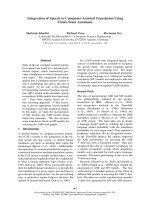

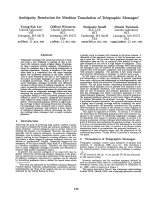
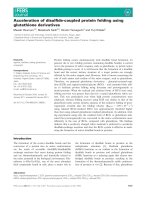
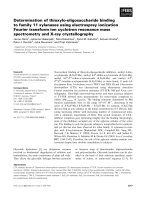
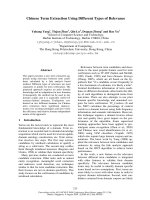
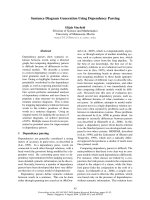
![Báo cáo khoa học: Characterization of the bioactive conformation of the C-terminal tripeptide Gly-Leu-Met-NH2 of substance P using [3-prolinoleucine10]SP analogues pdf](https://media.store123doc.com/images/document/14/rc/ty/medium_tyq1394220086.jpg)
